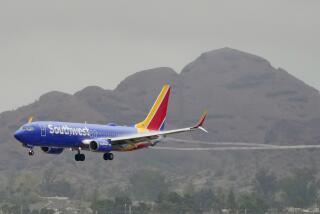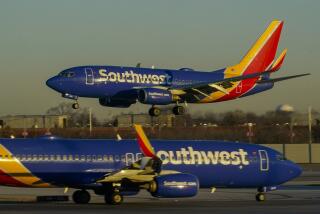L.A. Crash Is Just Latest Challenge for SkyWest Air : Airlines: Friday’s disaster was the company’s second in four years that may have been caused by an air traffic controller.
Friday’s fatal crash involving a SkyWest Airlines turboprop presents another challenge for the feisty St. George, Utah-based airline that was nursed back from the brink of bankruptcy 16 years ago.
Airline industry analysts and SkyWest officials said it was unlikely that the fatal crash at Los Angeles International Airport would chase away customers--especially since it appears that SkyWest was not at fault.
The psychic toll on SkyWest’s 1,300 employees is less certain. Government investigators think that the crash, which killed all 12 aboard the SkyWest plane, may have been caused by an air traffic controller error.
Only six weeks ago, a federal judge in Utah ruled that an air traffic controller was mostly to blame for a 1987 fatal midair collision involving a SkyWest plane. Eight people were killed in that accident over Kearns, Utah.
One SkyWest executive said later that the 1987 accident was “the toughest thing we ever had to deal with as a company.”
Ron Reber, SkyWest vice president-sales, was philosophical Sunday about the apparent similarities between the two accidents. “Any time there is a human element, this can happen,” he said. “I think it is important to say that our faith in the system isn’t shaken. If I lost faith in the system, I’d have to walk home.”
Nonetheless, Reber said, it was likely that the company would offer counseling today for SkyWest workers who need help dealing with the tragedy.
Reber was among 15 SkyWest employees who arrived in Los Angeles on Saturday to help families of those who died on the twin-engine commuter.
An arriving USAir jetliner crushed the 19-seat SkyWest plane as it waited on the runway for permission to take off. The National Transportation Safety Board said it appeared that instructions from an air traffic controller put the planes on a collision course.
The disaster will be another test of the airline’s resilience.
SkyWest got started 19 years ago, flying one plane between St. George and Salt Lake City. It soon ran into financial trouble.
In fact, it was headed toward bankruptcy when the founder’s nephew stepped in to bail it out. Jerry C. Atkin promising to send creditors a small amount of money each week in return for their patience. There were times when some creditors got only $5.
Atkin is now president and chief executive of the airline, which has a fleet of 48 turboprops that fly to 44 western cities. About 50% of its business is in California. In terms of departures, it is the third biggest airline at Los Angeles International Airport.
SkyWest has 22 turboprops on order. It is expected to take delivery of four this year, giving it room for expansion.
Reber said Sunday that SkyWest hopes to take over some routes from Orange County and Oakland that USAir will abandon in May. The airline’s revenue is expected to hit $110 million this year, up from $99.7 million in fiscal 1990.
“They are a first-rate, well-managed airline,” said Edward Starkman, an airline industry analyst with Paine Weber Inc. in New York. “They have never been cited for safety violations that I know of, and have one of the youngest fleets in the business.”
SkyWest’s trip from financial ruin was helped by the 1978 deregulation of the airline industry. Major airlines moved their jetliners to big cities, leaving the smaller markets to commuters. SkyWest took over abandoned routes to Flagstaff, Ariz., and other cities.
In 1984, SkyWest doubled its size with the acquisition of Palm Springs-based Sun Aire Lines. Then it teamed up with Western Airlines and changed its name to SkyWest Western Express. It flew passengers from smaller cities to Los Angeles and other large airports, where they could board Western flights.
After Western merged with Delta Air Lines, SkyWest signed on as a “Delta Commuter,” to feed passengers to that Atlanta-based airline.
The Delta-SkyWest partnership got off to a rocky start. An overhaul of Delta’s Los Angeles terminal discouraged passengers and made connections between SkyWest and Delta flights difficult.
Moreover, Delta had trouble merging its flight schedule with that of Western. Those timing problems hurt SkyWest because it was harder for the commuter to match its flight times with Delta’s changing flight schedule.
The early bumps in the Delta partnership contributed to SkyWest’s $2.28-million loss for fiscal 1988. The problems cleared up quickly, though, and now its relationship with Delta is viewed as a plus for SkyWest. Delta owns 20% of SkyWest and provides help with such marketing chores as advertising and ticket sales.
SkyWest hasn’t reported its financial results for the third quarter ended Dec. 31, 1990. It is expected to lose money, as have most other airlines, due to high jet-fuel costs. For fiscal 1990, SkyWest earned $4.72 million.
RELATED STORIES: A1, A3
More to Read
Inside the business of entertainment
The Wide Shot brings you news, analysis and insights on everything from streaming wars to production — and what it all means for the future.
You may occasionally receive promotional content from the Los Angeles Times.










